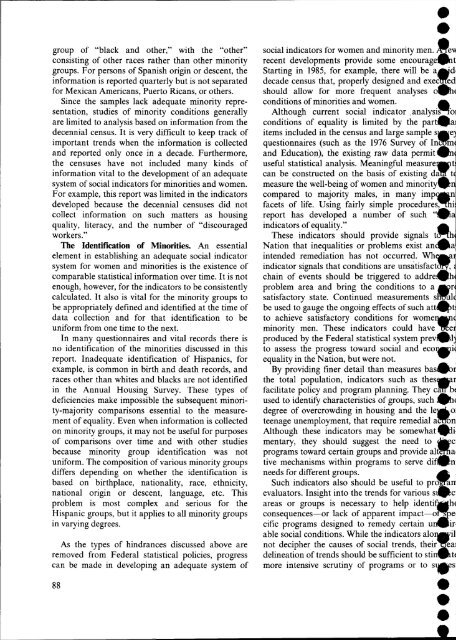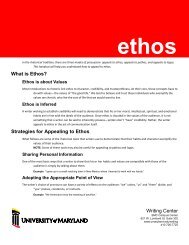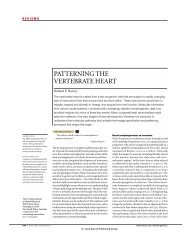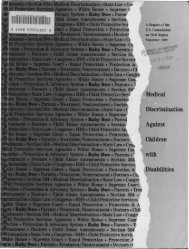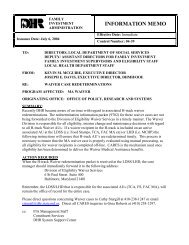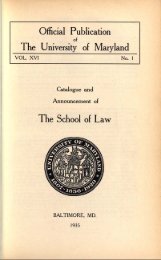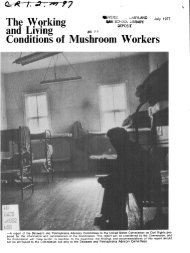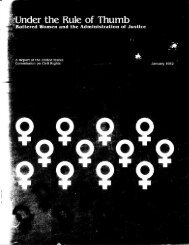group <strong>of</strong> "black <strong>and</strong> other," with the "other"consisting <strong>of</strong> other races rather than other minoritygroups. For persons <strong>of</strong> Spanish origin or descent, thein<strong>for</strong>mation is reported quarterly but is not separated<strong>for</strong> Mexican Americans, Puerto Ricans, or others.Since the samples lack adequate minority representation,studies <strong>of</strong> minority conditions generallyare limited to analysis based on in<strong>for</strong>mation from thedecennial census. It is very difficult to keep track <strong>of</strong>important trends when the in<strong>for</strong>mation is collected<strong>and</strong> reported only once in a decade. Furthermore,the censuses have not included many kinds <strong>of</strong>in<strong>for</strong>mation vital to the development <strong>of</strong> an adequatesystem <strong>of</strong> social indicators <strong>for</strong> minorities <strong>and</strong> women.For example, this report was limited in the indicatorsdeveloped because the decennial censuses did notcollect in<strong>for</strong>mation on such matters as housingquality, literacy, <strong>and</strong> the number <strong>of</strong> "discouragedworkers."The Identification <strong>of</strong> <strong>Minorities</strong>. An essentialelement in establishing an adequate social indicatorsystem <strong>for</strong> women <strong>and</strong> minorities is the existence <strong>of</strong>comparable statistical in<strong>for</strong>mation over time. It is notenough, however, <strong>for</strong> the indicators to be consistentlycalculated. It also is vital <strong>for</strong> the minority groups tobe appropriately defined <strong>and</strong> identified at the time <strong>of</strong>data collection <strong>and</strong> <strong>for</strong> that identification to beuni<strong>for</strong>m from one time to the next.In many questionnaires <strong>and</strong> vital records there isno identification <strong>of</strong> the minorities discussed in thisreport. Inadequate identification <strong>of</strong> Hispanics, <strong>for</strong>example, is common in birth <strong>and</strong> death records, <strong>and</strong>races other than whites <strong>and</strong> blacks are not identifiedin the Annual Housing Survey. These types <strong>of</strong>deficiencies make impossible the subsequent minority-majoritycomparisons essential to the measurement<strong>of</strong> equality. Even when in<strong>for</strong>mation is collectedon minority groups, it may not be useful <strong>for</strong> purposes<strong>of</strong> comparisons over time <strong>and</strong> with other studiesbecause minority group identification was notuni<strong>for</strong>m. The composition <strong>of</strong> various minority groupsdiffers depending on whether the identification isbased on birthplace, nationality, race, ethnicity,national origin or descent, language, etc. Thisproblem is most complex <strong>and</strong> serious <strong>for</strong> theHispanic groups, but it applies to all minority groupsin varying degrees.As the types <strong>of</strong> hindrances discussed above areremoved from Federal statistical policies, progresscan be made in developing an adequate system <strong>of</strong>social indicators <strong>for</strong> women <strong>and</strong> minority men. m&recent developments provide some encourage^piStarting in 1985, <strong>for</strong> example, there will be a£acdecade census that, properly designed <strong>and</strong> execmedshould allow <strong>for</strong> more frequent analyses o|^lconditions <strong>of</strong> minorities <strong>and</strong> women. 4^Although current social indicator .analysis^}conditions <strong>of</strong> equality is limited by the panitems included in the census <strong>and</strong> large sample Jquestionnaires (such as the 1976 Survey <strong>of</strong> Ii<strong>and</strong> Education), the existing raw data permituseful statistical analysis. Meaningful measurecan be constructed on the basis <strong>of</strong> existing da 1measure the well-being <strong>of</strong> women <strong>and</strong> minorityfPbncompared to majority males, in many iifacets <strong>of</strong> life. Using fairly simple procedures?report has developed a number <strong>of</strong> such "indicators <strong>of</strong> equality."These indicators should provide signals tNation that inequalities or problems exist amintended remediation has not occurred. Whindicator signals that conditions are unsatisfactchain <strong>of</strong> events should be triggered to addreproblem area <strong>and</strong> bring the conditions to asatisfactory state. Continued measurements SJbe used to gauge the ongoing effects <strong>of</strong> such att
stments to them. Through these indicators,SSIIttion is focused on the limited effect <strong>of</strong> recentral ef<strong>for</strong>ts to enhance the conditions <strong>of</strong> womenminority men relative to majority males, indicatneed<strong>for</strong> more effective policy <strong>and</strong> programoanation.^The concern <strong>of</strong> societies with "how well we are^Pg" has existed <strong>for</strong> centuries. Annually, theftawdent <strong>of</strong> the United States addresses this subjectrr^ie state <strong>of</strong> the Union address. With the use <strong>of</strong> thej^l <strong>of</strong> social indicators contained in this report, wecjj^state more adequately how the Nation is doing intfl^ask <strong>of</strong> achieving its goal <strong>of</strong> equality.Foldingssocial indicators presented in this reportclear documentation <strong>of</strong> many continuingserious problems <strong>of</strong> inequality afflicting theps studied. In addition to the inequalitiesdj^ussed below, deficiencies in the Federal statisticalalso have been identified.ationlayed Education. The percentage <strong>of</strong> women <strong>and</strong>rity men in 1976 who were 2 or more yearstn^nd the average grade <strong>for</strong> their age was approxitwicethe percentage <strong>for</strong> majority males,ough there was slight relative improvementthe 1960s <strong>for</strong> some <strong>of</strong> the groups, 3 mostbecame relatively more delayed from 1970 toindicating increased inequality.I School Nonattendance. The percentage <strong>of</strong>between 15 <strong>and</strong> 17 years <strong>of</strong> age who were notid in school in most instances has declined1960 <strong>and</strong> even since 1970 <strong>for</strong> many groups, 5buk b^ as <strong>of</strong> 1976, relative to majority males, thelilni ihood <strong>of</strong> being in school has not improved <strong>for</strong>groups. 6 In fact, young people in some groupst least twice as likely as majority males to be outAmerican <strong>and</strong> Puerto Rican males <strong>and</strong> American IndiskanNative females.ierican Indian/Alaskan Native, black, Mexican American, <strong>and</strong> Puertomales <strong>and</strong> American Indian/Alaskan Native, black, Mexicanan, <strong>and</strong> Puerto Rican females.Jferican Indian/Alaskan Native <strong>and</strong> Mexican American males <strong>and</strong>^niR:an Indian/Alaskan Native, Mexican American, <strong>and</strong> Puerto RicanIndian/Alaskan Native <strong>and</strong> Mexican American males <strong>and</strong>ican Indian/Alaskan Native, Mexican American, <strong>and</strong> Puerto Rican(Terican Indian/Alaskan Native (2.8) <strong>and</strong> Mexican American (2.2)<strong>and</strong> American Indian/Alaskan Native (3.0), Mexican American (2.8),ani^uerto Rican (3.2) females.Jferican Indian/Alaskan Native, black, Mexican American, <strong>and</strong> Puerto<strong>of</strong> school at this important stage in their development.7High School Completion. Despite noticeable improvementbetween 1960 <strong>and</strong> 1976 in high schoolcompletion by women <strong>and</strong> minority men, mostgroups in 1976 remain considerably less likely thanmajority males to have completed high school. 8College Completion. The percentage <strong>of</strong> personsfrom 25 to 29 years <strong>of</strong> age who have completed 4years <strong>of</strong> college is far lower <strong>for</strong> most minority <strong>and</strong>female groups than <strong>for</strong> majority males. 9 Althoughmost groups improved slightly relative to majoritymales during the decade <strong>of</strong> the 1960s, there weresome whose rates declined relative to majority malesfrom 1970 to 1976, 10 <strong>and</strong>, in 1976, most groupsremained less than 35 percent as likely as majoritymales to have completed college. 11High School Overqualification. The percentage <strong>of</strong>high school graduates who are employed in occupationsthat typically require less than a high schooldegree was much higher <strong>for</strong> minority males, minorityfemales, <strong>and</strong> majority females than <strong>for</strong> majoritymales in 1976.College Overqualification. The percentage <strong>of</strong> collegegraduates who are employed in occupations thattypically require less than a college degree isgenerally higher <strong>for</strong> minority males than <strong>for</strong> majoritymales. The disparity generally declined slightlyduring the decade <strong>of</strong> the 1960s, but increased duringthe first part <strong>of</strong> the 1970s. The relative advantage <strong>of</strong>some female groups became statistically nonsignificantby 1976. 12Earnings Differentials <strong>for</strong> College-Educated Persons.The median income was considerably lower <strong>for</strong>women <strong>and</strong> minority males with 4 or more years <strong>of</strong>college than <strong>for</strong> majority males with comparableeducational attainment. The disparity has tended todiminish somewhat over time, but not <strong>for</strong> allgroups, 13 <strong>and</strong> the disparity in earnings still remainedvery large in 1976. For instance, none <strong>of</strong> the college-Rican males <strong>and</strong> American Indian/Alaskan Native, black, MexicanAmerican, Pilipino American, <strong>and</strong> Puerto Rican females.9 American Indian/Alaskan Native, black, Mexican American, <strong>and</strong> PuertoRican males <strong>and</strong> American Indian/Alaskan Native, black, MexicanAmerican, Puerto Rican, <strong>and</strong> majority females.10 American Indian/Alaskan Native males <strong>and</strong> American Indian/AlaskanNative, black, <strong>and</strong> Puerto Rican females.11 American Indian/Alaskan Native, black, Mexican American, <strong>and</strong> PuertoRican males <strong>and</strong> American Indian/Alaskan Native, black, MexicanAmerican, <strong>and</strong> Puerto Rican females.12 American Indian/Alaskan Native, Puerto Rican, <strong>and</strong> majority females.13 The disparity has increased or remained the same, relative to majoritymales, <strong>for</strong> Mexican American, Japanese American, <strong>and</strong> Chinese Americanmales.89
- Page 1 and 2:
Thurgood Marshall Law LibraryThe Un
- Page 5:
Letter of TransmittalU.S. COMMISSIO
- Page 8 and 9:
Contents1. Introduction 12. Educati
- Page 11 and 12:
CJupter 1Introductionr stematic eva
- Page 13 and 14:
nWiave different geographic distrib
- Page 15 and 16:
Craipter 2lucation/, education is p
- Page 17 and 18:
Social Indicator Values: Ratios of
- Page 19 and 20:
;ame incomes as those who complete
- Page 21 and 22:
Social Indicator Values: Ratios of
- Page 23 and 24:
Social Indicator Values: Ratios of
- Page 25 and 26:
Social Indicator Values: Ratios of
- Page 27 and 28:
;orae consequences of educational a
- Page 29 and 30:
catiSocial Indicator Values: Ratios
- Page 31 and 32:
Social Indicator Values: Ratios of
- Page 33 and 34:
Earnings$16,000"Majority Males14,00
- Page 35 and 36:
Social Indicator Values: Ratios of
- Page 37 and 38:
suWeed in completing a college educ
- Page 39 and 40:
number of persons who were not work
- Page 41 and 42:
Social Indicator Values: Ratios of
- Page 43 and 44:
Social Indicator Values: Ratios of
- Page 45 and 46:
cupationTABLE 3.3Prestige Scores fo
- Page 47 and 48: Social Indicator Values: Ratios of
- Page 49 and 50: :fflmge that do not in fact indicat
- Page 51 and 52: Social Indicator Values: Ratios of
- Page 53 and 54: Compared with majority males.! Male
- Page 55 and 56: some groups, the dissimilarity was
- Page 57 and 58: #(Mipter 4Income and Povertybased o
- Page 59 and 60: TABLE 4.1Median Income of Families:
- Page 61 and 62: Social Indicator Values: Ratios of
- Page 63 and 64: smre the ratio was higher at 0.52 i
- Page 65 and 66: Earnings Ralros for Adjusted(group/
- Page 67 and 68: Earnings$16,000^Majority Males14,00
- Page 69 and 70: InSocial Indicator Values: Ratios o
- Page 71 and 72: TABLE 4.5erty Cutoffs in 1975 by Se
- Page 73 and 74: Familiesand UnrelatedIndividualsAme
- Page 75 and 76: alWus government programs. If the P
- Page 77 and 78: Carter 5MousingWK statistical repor
- Page 79 and 80: filar climate and housing market) a
- Page 81 and 82: i uSocial Indicator Values: Ratios
- Page 83 and 84: Social Indicator Values: Ratios of
- Page 85 and 86: in the other housing indicators, mi
- Page 87 and 88: All Households-Renter OccupiedAmer.
- Page 89 and 90: general, minority homeowners were m
- Page 91 and 92: Social Indicator Values: Ratios of
- Page 93 and 94: Social Indicator Values: Ratios of
- Page 95 and 96: about one-half to two-thirds as lik
- Page 97: mal tables that made up the primary
- Page 101 and 102: IIT^) 1anpmeownership. Homes of maj
- Page 103 and 104: g on the work begun in the Commerce
- Page 105 and 106: Ed. PrestigeOccupational Title Req.
- Page 107 and 108: 21HsusWe Occupational Title«5 Insp
- Page 109 and 110: nsus Ed. Prestigeode Occupational T
- Page 111 and 112: susde Occupational Title|63 Sewers
- Page 113 and 114: Occupational TitleGanged Occupation
- Page 115 and 116: $364.62 will be added to the estima
- Page 117 and 118: GroupFemaleConstantBAgeBSchoolYBPre
- Page 119 and 120: "majority" was identified as the po
- Page 121 and 122: Number of Cases for Each Social Ind
- Page 123 and 124: INCOME AND POVERTYGroupTextTableSoc
- Page 125 and 126: Number of Unweighted Cases for Each
- Page 127 and 128: TABLE C-2Standard Deviations for Pr
- Page 129 and 130: flrrnings Differential for College-
- Page 131 and 132: trP persons would have less income
- Page 133 and 134: Part II:Computer ProgramsFOLLOWING
- Page 135 and 136: I FORMAT(1X,2A4,A2,I4,1X,2I4)f1 WKE
- Page 137 and 138: T MEDIUMCASESCATEE LABELSHOURS1 55-
- Page 139 and 140: IIMENT(FOR NON-HEAD TO INSURE RIGHT
- Page 141 and 142: INTEGER OCC,SEX,AGE,IDDIMENSION X(1
- Page 143 and 144: (SET EQ 4) G4 = 1.0(SET EQ 5) G5 =
- Page 145 and 146: STATE(43)=22.99STATE(81)=3.42STATE(
- Page 148:
U. S. COMMISSION ON CIVIL RIGHTSWAS


